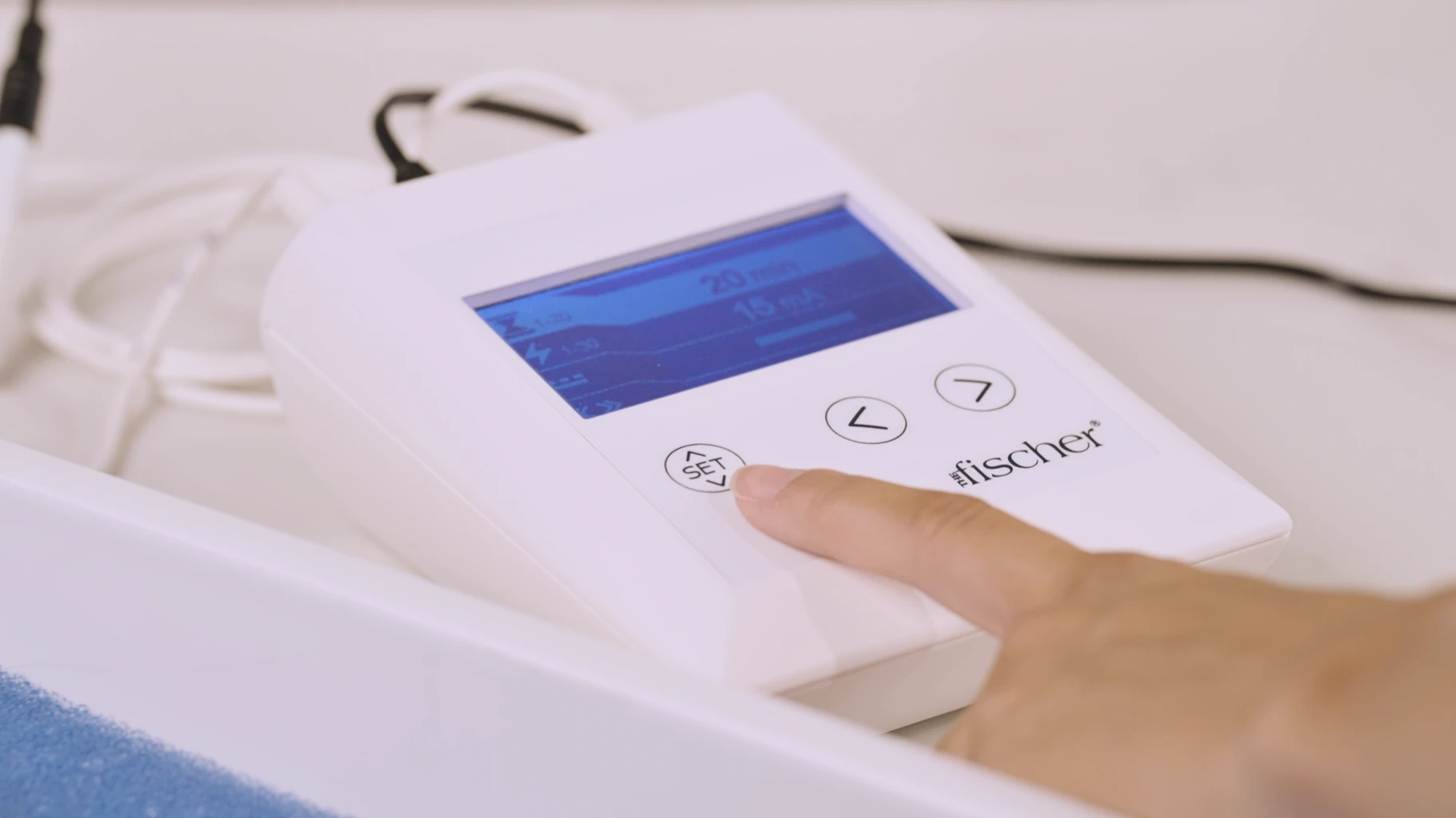September 25, 2023
No Comments
By
Daniel Moyer
WHY PREVIOUS ATTEMPTS AT IONTOPHORESIS MAY NOT HAVE WORKED
TAP WATER & SWEAT GLANDS
Iontophoresis relies on a mild electrical current to deliver the natural minerals found in tap water to affected sweat glands as well as along the conduction system.
After several sessions, this ion current has been clinically proven to reduce perspiration without damaging the sweat glands. However, not all patients have this experience at first.
After several sessions, this ion current has been clinically proven to reduce perspiration without damaging the sweat glands. However, not all patients have this experience at first.
![Close up image of a hand of a person who has hyperhidrosis. Hand covered in sweat. Behind hand is pen and piece of paper with sweat marks sitting on a wooden desk. [insurance coverage for medical supplies] [ RA fischer hyperhidrosis iontophoresis ]](https://www.rafischer.com/wp-content/uploads/2023/09/before-and-after-the-fischer-iontophoresis-device-treatment-hyperhidrosis-sweat-ra-dermatology-5-scaled.webp)
Whether you had previously tried and failed treatments for hyperhidrosis or saw diminished effectiveness over time, here is why previous attempts at iontophoresis may not have worked for you.
SOFT WATER
During iontophoresis, tap water serves as an electrically conductive medium between the electrodes and your skin. Minerals like calcium, magnesium, and potassium are delivered into the skin, essentially “plugging them up” to create an all-natural dryness barrier. However, some houses have water-softening systems that filter out these necessary minerals. Or you may find yourself in an area of the country where the well water is naturally soft. Soft water may have been why iontophoresis didn’t work for you in the past.
Fix: Adding baking soda, using an exterior water source like a hose, or buying mineral water from the store.
THE WRONG CURRENT
During iontophoresis, the current is applied as either a constant Direct Current or Pulsed Current. These two current types differ in their therapeutic effectiveness and perceived sensation. Dermatologists consider direct current more effective because the application is constant and consistent. With Direct Current, patients experience faster results.
Pulsed current is perceived as being a more comfortable experience because you can tolerate higher current levels. Due to the inconsistent flow of Pulsed Current, the therapeutic dose (or milliamperes) cannot compare with that of Direct Current. Pulsed current is more frequently applied for those with sensitivity issues or pediatric patients.
Imagine two rooms. In one, you turn the lights on, wait for 20 minutes, and then turn them off. That’s Direct Current. In room #2, the light bulbs are brighter, but you can’t tolerate that much brightness, so you keep flickering the lights on and off for twenty minutes. That’s Pulsed Current.
While both current types have their own use, treating with the wrong one may have been why iontophoresis didn’t work for you in the past.
While both current types have their own use, treating with the wrong one may have been why iontophoresis didn’t work for you in the past.
FIX: An iontophoresis device like The Fischer that features both Direct Current and Pulsed Current settings, giving you the flexibility to treat for faster results or a more comfortable experience.

"For a person suffering from excessive sweating, direct current iontophoresis is the only choice."
Dr. Rolf Eilers - Saalmann Medical
NOT TREATING FOR LONG ENOUGH
At RA Fischer, our Treatment Specialists recommend that patients begin iontophoresis treatments at 20-minutes per area. During the initial phase of our 3-phased treatment approach, the goal is to reduce sweat within the first two weeks with an every-other-day session.
Following this initial phase, a gradual reduction in sessions – from 3x a week to 1-2 sessions per week, and so on – is required to maintain therapeutic success. For patients with palmar and plantar hyperhidrosis, this is when you can transition to treating both hands and both feet at the same time, effectively reducing the treatment time in half.
Once you’ve achieved 100% consistent dryness, you’ve reached the maintenance phase of iontophoresis and can now treat on an “as needed” basis. Some patients can go 4-6 weeks in between 20-minute sessions.
Not treating for long enough, or following the wrong treatment plan, may have been why iontophoresis didn’t work for you in the past.
Following this initial phase, a gradual reduction in sessions – from 3x a week to 1-2 sessions per week, and so on – is required to maintain therapeutic success. For patients with palmar and plantar hyperhidrosis, this is when you can transition to treating both hands and both feet at the same time, effectively reducing the treatment time in half.
Once you’ve achieved 100% consistent dryness, you’ve reached the maintenance phase of iontophoresis and can now treat on an “as needed” basis. Some patients can go 4-6 weeks in between 20-minute sessions.
Not treating for long enough, or following the wrong treatment plan, may have been why iontophoresis didn’t work for you in the past.
FIX: Following our treatment plan or speaking to one of our Treatment Specialists with specific questions about your symptoms and experience.
IS THE FISCHER RIGHT FOR YOU?
Compared to narrow metal electrodes or compact iontophoresis options, the proportions of The Fischer’s water bath trays, pH-balancing foam inserts, and silicone-graphite electrodes conveniently accommodate simultaneous treatment of hands and feet without sacrificing effectiveness.
From our experience here at RA Fischer, dual treatment is especially beneficial for pediatric hyperhidrosis patients. The shorter session duration can help them mentally embrace the treatment, which helps to ensure success. Our Fischer boasts a 98% success rate for patients!
From our experience here at RA Fischer, dual treatment is especially beneficial for pediatric hyperhidrosis patients. The shorter session duration can help them mentally embrace the treatment, which helps to ensure success. Our Fischer boasts a 98% success rate for patients!
THE FISCHER
Reach out today
Contact one of our Treatment Specialists today to answer any and all of your questions about the Fischer.
Leave a Reply Cancel reply
You must be logged in to post a comment.